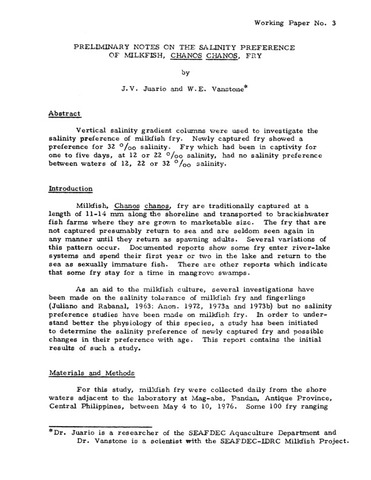Survival and settlement rates of Haliotis asinina larvae at different salinity levels
- Global styles
- MLA
- Vancouver
- Elsevier - Harvard
- APA
- Help

ดู/เปิด
วันที่
2013Page views
1,088ASFA keyword
AGROVOC keyword
เมตาดาต้า
แสดงระเบียนรายการเต็มCited times in Scopus
- Captures
- Mendeley - Readers: 2
Share
นามธรรม
The study was conducted to determine the optimum salinity levels (24 ppt, 28 ppt, 32 ppt, 36 ppt and 40 ppt) for the survival and settlement rates of H. asinina in a complete randomized design with three replicates each. The experimental animals were reared in 15 glass aquaria for the first run and in plexiglass for the second run. Feeding of Navicula spp. was done once a day. Temperature and dissolved oxygen were monitored throughout the experiment. Data were analyzed using One-Way ANOVA to determine significant difference among treatments at 0.05 level of significance using Social Package for Social Science. Result of the first run showed that 32 ppt had the highest mean survival (1.50%) and mean settlement rate (1.84%). Similar result was also observed in 32 ppt with highest mean survival (9.72%) and mean settlement rate (16.42%). Significant difference existed among treatments during the second run of the experiment. Results showed that 28 ppt and 32 ppt were the optimum salinity levels for survival and settlement rate of H. asinina. Further study should be conducted to determine the tolerance and settlement rates of H. asinina larvae to lower salinities until it reaches juvenile stage with first respiratory pore appearing.
การอ้างอิง
Maquirang, J. R. H., Caturao, R. D., Maquirang, J. H., & Pedroso, F. L. (2013). Survival and settlement rates of Haliotis asinina larvae at different salinity levels. IAMURE International Journal of Ecology and Conservation , 8(1), 81-95. https://doi.org/10.7718/ijec.v8i1.745
Type
ArticleISSN
2244-1573; 2244-1581คอลเลกชัน
- Journal Articles [1249]
Related items
Showing items related by title, author, creator and subject.
-
Growth response of Nile tilapia fry to salinity stress in the presence of an ‘internal reference’ fish
Basiao, Zubaida U.; Eguia, Ruel V.; Doyle, Roger W. (Blackwell Publishing, 2005)Growth of three strains of Oreochromis niloticus L. fry exposed to salinity stress in the presence of an internal reference fish were compared. The Central Luzon State University (CLSU) strain was obtained from the Freshwater ... -
Preliminary notes on the salinity preference of milkfish, Chanos chanos, fry
Juario, Jesus V.; Vanstone, William E. (Aquaculture Department, Southeast Asian Fisheries Development Center, 1976)Vertical salinity gradient columns were used to investigate the salinity preference of milkfish fry. Newly captured fry showed a preference for 32‰ salinity. Fry which had been in captivity for one to five days, at 12 or ... -
Optimum low salinity to reduce cannibalism and improve survival of the larvae of freshwater African catfish Clarias gariepinus
Kawamura, Gunzo; Bagarinao, Teodora ; Yong, Annita Seok Kian; Sao, Pei Wen; Lim, Leong Seng; Senoo, Shigeharu (Springer Verlag, 2017)
The freshwater African catfish Clarias gariepinus is carnivorous and cannibalistic even during the larval and juvenile stages and this behavior causes economic losses in aquaculture. This study examined for the first time ...
; Yong, Annita Seok Kian; Sao, Pei Wen; Lim, Leong Seng; Senoo, Shigeharu (Springer Verlag, 2017)
The freshwater African catfish Clarias gariepinus is carnivorous and cannibalistic even during the larval and juvenile stages and this behavior causes economic losses in aquaculture. This study examined for the first time ...





